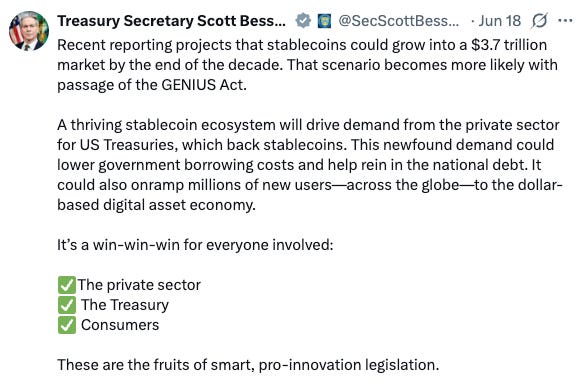The GENIUS Act of 2025 (“Guiding and Establishing National Innovation for U.S. Stablecoins”) is the first federal framework dedicated entirely to payment stablecoins. Passed by the Senate with a 68–30 vote on 17 June 2025, it now heads to the House for reconciliation with its own version, the STABLE Act, before being sent to President Trump for signature.
Why it matters
Stablecoins have long existed in a legal grey zone. The GENIUS Act finally brings clarity—defining who can issue them, how reserves must be held, and which regulators are in charge. It essentially transforms a Wild West corner of crypto into something that more closely resembles traditional finance, both in structure and regulation.
Some key rules:
Issuers must be licensed.
Every stablecoin must be fully backed by cash, U.S. Treasuries, or other high-quality liquid assets.
Issuers must publicly disclose their reserve composition regularly.
In bankruptcy, token-holders take priority over unsecured creditors.
What are the implications?
Good for Crypto Platforms
This is undoubtedly positive for crypto—it lends legitimacy to stablecoins. The irony, of course, is that crypto was created to disrupt the financial system, but now stablecoins are being absorbed into it.
Still, markets celebrated. Circle Internet, the first publicly listed stablecoin issuer, surged 34% following the Senate vote. We’ve talked about its meteoric rise since its IPO two weeks ago.
Crypto trading platforms also rallied—Coinbase rose 16% and Robinhood 5%. Coinbase likely benefited more due to its revenue-sharing agreement with Circle, whose USDC stablecoin is now seeing greater adoption.
Good for U.S. Treasuries and the Dollar
From the U.S. government's perspective, this isn't about endorsing crypto—it's about propping up demand for the dollar and Treasuries.
Remember a few months ago, when fears over U.S. debt spiked bond yields and weakened the dollar? There were even discussions about the USD losing its reserve currency status.
Stablecoins are part of the solution. To maintain a 1:1 USD peg, stablecoins like USDC must hold reserves in USD-denominated assets—primarily cash and U.S. Treasuries. As stablecoin usage grows, so does structural demand for both the dollar and Treasuries.
As U.S. Treasury Secretary Scott Bessent posted on X:
The U.S. has every reason to embrace stablecoins as a monetary tool.
Bad for Traditional Payment Networks (At Least Initially)
After the GENIUS Act passed, Visa and Mastercard shares dropped about 5%, while Corpay, Paycom, and PayPal fell 3–4%.
Why? Because stablecoins operate on blockchain networks like Ethereum, Solana, and Polygon—completely bypassing traditional banking rails. These on-chain payments don’t need Visa or Mastercard infrastructure.
There’s now a growing fear that as merchants and users adopt stablecoin-based payments, the traditional networks could lose relevance.
But I believe this was a knee-jerk reaction. I’d consider buying Visa and Mastercard—but not just yet, as neither stock looks undervalued despite the dip.
Importantly, both Visa and Mastercard have already integrated stablecoin settlement into their systems. They’re not ignoring the threat—they’re co-opting it. Rather than fight crypto, traditional finance is adapting to it.
Final Thoughts
The GENIUS Act doesn’t signal crypto’s victory over traditional finance—it signals crypto’s absorption into it.
In the end, crypto hasn’t disrupted the financial system. What it has done is expand the ways money can move, making the entire system more flexible, more global, and more efficient.






